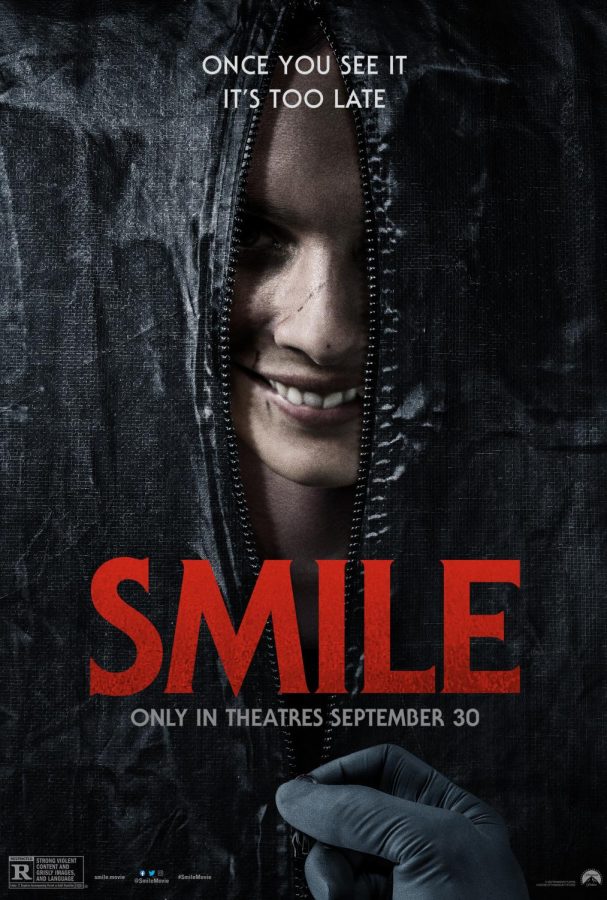“Smile”: A Scary Good Movie
As a horror fan who doesn’t scare easily, I knew I had to see “Smile.” Also, as a film minor, I had to see the movie that created box office buzz through their genius marketing. Because of that, there will be no spoilers in this review. The week leading up to opening in the box office, the “Smile” marketing team placed grinning people in the audience at MLB games. This sparked a viral craze on TikTok and the official “Smile” website, where fans can report seemingly creepy smiles. Sitting in an almost full theater was comforting, both as a nervous viewer and a prospective film maker. There’s something different about viewing a movie with a collective group, hearing the gasps, jumping at the sound of a can of cat food opening, then laughing about it. I walked out of the theater unafraid, leaving me to conclude that “Smile” is a beautifully creepy cinematic film that lacks effective horror techniques, such as suspense.
“Smile” is directed by Parker Finn, has cinematography by Charlie Sarroff, and stars Sosie Bacon, Jessie T. Usher, Kyle Gallner, Kal Penn and Rob Morgan. It is based off of the short film “Laura Hasn’t Slept” by the same director, released in 2020. Cinematically, the film is beautifully shot. However, some of the acting does not hold up and the plot is predictable. “Smile” is entertaining, but did not meet my standards that were created by the positive online audience reviews and unique, alarming advertising. The film is effective at relaying the feelings of outsiderness and unsettledness through the isolation of the main character, Rose (Bacon), in addition to dizzying spinning, upside down, and sideways Dutch-angle shots which convey the message that something is off. With that being said, I do not recommend this film for anyone sensitive to the topic of mental health. Also, some scenes utilize disturbing gore, especially with the intense last 20 minutes of the film. Viewer discretion is advised.
When Rose undergoes a traumatizing experience, her husband tries to comfort her, but his emotions fall short, possibly on purpose or bad acting — it’s hard to tell. Either way, Jessie T. Usher’s artificial performance drew me out of the movie experience. More emotions fall short, lacking suspense throughout the film. Instead, the film crew opts for cheap surprises all the way to the strange, goofy special effects towards the end. All this aside, the few minutes of bad acting, predictability, and cheap jumpscares created by quick jump cuts, “Smile” takes a simple concept and gets into the viewer’s head through creepy visuals that will stay with you for days.
“Smile” does not have a definite resolution or statement on the main theme of mental health. In today’s society, we now know that talking about mental health is important, and “Smile” shows this fact, but does not address it head on. Through the main character, Rose, the film asks the question: “does it matter if what someone experiences is real or not?” As Rose is a therapist, this concept of imagination versus reality further complicates the proposed question, keeping the viewer on their toes by constantly having to question what is the character’s imagination or reality in every scene. All senses are evoked and heighted. Our hearts race at the sound of the slow, rhythmic, classic horror style soundtrack and when the music cuts and silence fills the theater, setting us up for a scare. As a viewer, we feel sympathetic to what is seen and heard in the hospital, or a phantom pain when Rose nervously bites her fingernail to the point of blood drawn. The viewer feels and identifies with Rose, while cheering her on to defeat the confusing possible plague or possible mental break.
“Smile” also investigates the American smile in an almost maskless world, post COVID-19, carrying a deeper meaning to the facial feature that was hidden for years. The smiling American stereotype relays a politeness common among Americans. This cultural grin can be identified by the pursing of the lips and a slight upturn at the corners, possibly confusing to outsiders. “Smile”, the film, mimics this simple cultural facial expression with a twist.



